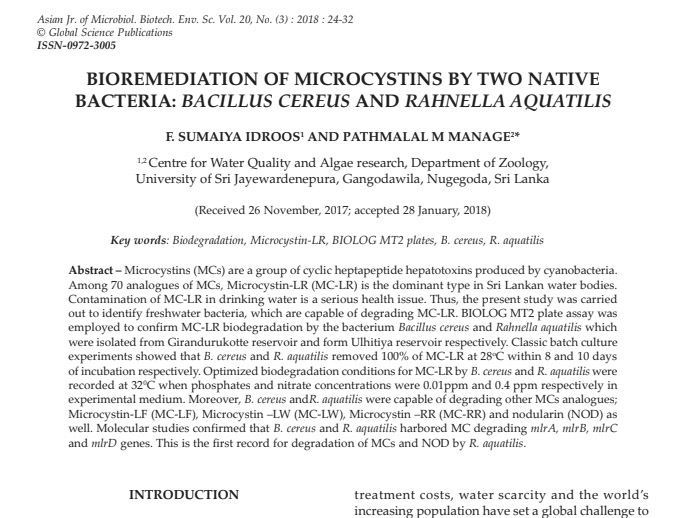Authors: Sumaiya Idroos and Pathmalal Manage
Journal: Asian Journal of Microbiology, Biotechnology & Environmental Sciences.
Microcystins (MCs) are a group of cyclic heptapeptide hepatotoxins produced by cyanobacteria. Among 70 analogues of MCs, Microcystin-LR (MC-LR) is the dominant type in Sri Lankan water bodies. Contamination of MC-LR in drinking water is a serious health issue. Thus, the present study was carried out to identify freshwater bacteria, which are capable of degrading MC-LR. BIOLOG MT2 plate assay was employed to confirm MC-LR biodegradation by the bacterium Bacillus cereus and Rahnella aquatilis which were isolated from Girandurukotte reservoir and form Ulhitiya reservoir respectively. Classic batch culture experiments showed that B. cereus and R. aquatilis removed 100% of MC-LR at 28oC within 8 and 10 days of incubation respectively. Optimized biodegradation conditions for MC-LR by B. cereus and R. aquatilis were recorded at 320C when phosphates and nitrate concentrations were 0.01ppm and 0.4 ppm respectively in experimental medium. Moreover, B. cereus andR. aquatilis were capable of degrading other MCs analogues; Microcystin-LF (MC-LF), Microcystin –LW (MC-LW), Microcystin –RR (MC-RR) and nodularin (NOD) as well. Molecular studies confirmed that B. cereus and R. aquatilis harbored MC degrading mlrA, mlrB, mlrC and mlrD genes. This is the first record for degradation of MCs and NOD by R. aquatilis.


